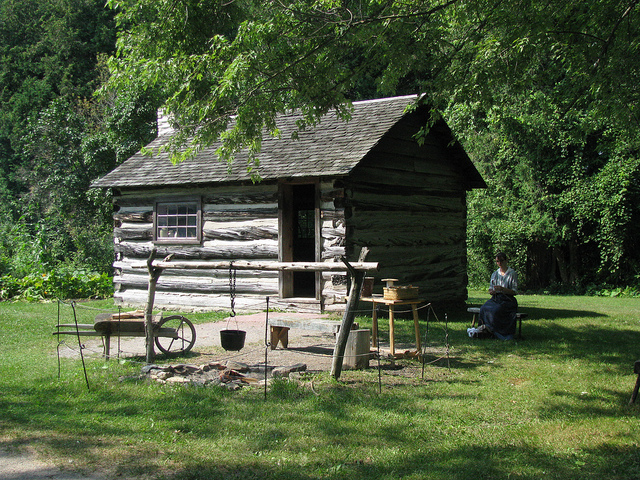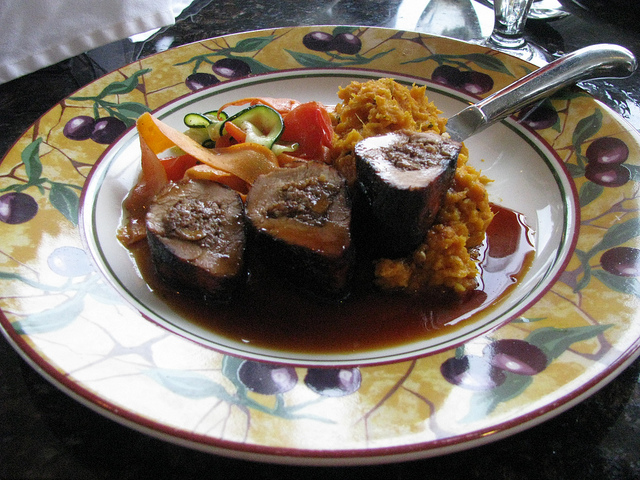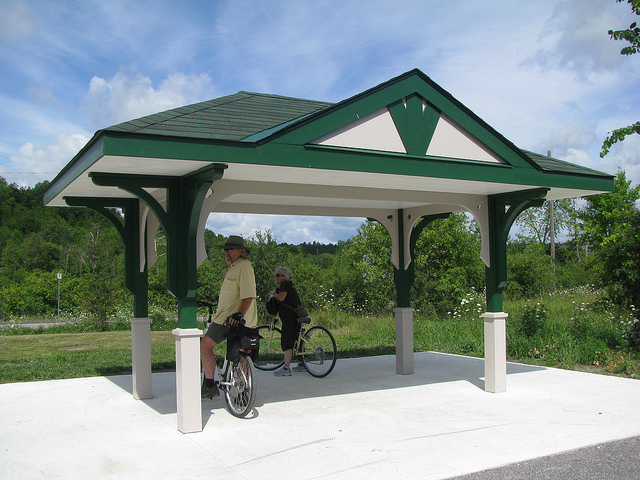Day 2 of my Peterborough adventure started with gorgeous sunshine. Cora Whittington, my hostess at the Golden Pathways B&B, and I were talking in the kitchen while she prepared my breakfast: a healthy fruit salad, decorated with colourful edible flowers from her garden, and savoury crepes with Hollandaise sauce. Magnum, the world’s friendliest beagle, kept us company. When Cora had finished cooking, she joined me on the veranda for breakfast and we enjoyed a great chat on a beautiful morning.

Cora Whittington makes a delicious and colourful fruit salad
But then I had to get going to embark on my explorations around Peterborough. Driving on rolling country roads I headed east to the village of Keene which is home to the Lang Pioneer Village, a living history museum dedicated to preserve, promote and authentically recreate the rural history of Peterborough County.

Joe Corrigan provides me with an overview of Lang Pioneer Village
To start my educational outing, I met with Joe Corrigan, the museum’s manager. In his overview of the museum, he explained that 25 historic and recreated buildings were brought together from around Peterborough County for the 1967 Centennial Project. More than 800,000 people have visited Lang Pioneer Village over the last 43 years and enjoyed the first-hand living history lessons available here.

Julia Gregory (on the right) with a few youth interpreters at Lang Pioneer Village
Joe connected me with Julia Gregory, one of the historical interpreters at the museum, who was dressed up in full period costume. Julia started to take me on a tour of this unique complex and we started with the Lang Grist Mill, located across the bridge on the other side of the Indian River. Originally built in 1846, the Lang Grist Mill burnt down in 1896 with only the exterior stone walls remaining. The interior of the mill was rebuilt and presents itself in the 1896 condition.

The Lang Grist Mill originally dates from 1846
Julia explained that the Indian River had tremendous economic significance for the region. It connects Stony Lake with Rice Lake and was a major route of transportation for early settlers. At some point there were 12 mills along the Indian River, and even today there are still two active mills: the Lang Grist Mill, and the Hope Mill, a saw mill that is still in operation today. But in the times before the Lang Grist Mill was built, pioneer farmers had to take their grain all the way to Cobourg to be milled, a gigantic distance at a time before the arrival of the railway.

A view over the picturesque mill pond
We went inside the mill and on three levels I was fascinated by the waterwheel, the belts, the elevators that moved grain up and down between the different levels, and the sifters who separate the milled grains into different grades. To see these complicated and ingenious mechanisms that dated back over a hundred years was fascinating. Everything was operated by pure water power without any electricity at all and the mill was surprisingly quiet.

Complicated mechanisms operate the Lang Grist Mill, all without electricity
I also had a chance to meet Francis Cardwell, the miller, who regularly takes school groups on tours of the mill and explains the workings of the mill to children, many of whom have absolutely no idea how flour is made and where bread actually comes from. Francis, in her take-charge kind of way, guided a large group of children through the whole building. A manual grinder allows visitors to grind wheat grains to understand and see the milling process first-hand.

Francis Cardwell, the miller, provides guided tours of the Lang Grist Mill
My expert guide Julia then took me back to the main visitor centre which houses the Gift Shop, the Main and MacKelvie Galleries. Inside there was a special temporary exhibition by the Kawartha Artists and Vera Penrose, one of the artists, showed me around the room which featured a wide variety of landscape paintings in watercolour, oil and acrylic. Some of the artists were here today to do some outdoor painting in the beautiful setting of the Lang Pioneer Village.

Kawartha Artists hard at work
Then Julia took me into the carpenter’s workshop where a young man by the name of John Hodson was demonstrating pioneer woodworking skills. John grew up in the area and currently attends a mechanical engineering program at college. But for the last few years his summer job has been to work at the Lang Pioneer Village, honing and displaying his skills as a carpenter. He showed us how to operate several of the human-powered machines: a scroll saw, a treadle lathe and a foot-powered vise. He even pointed out a coffin he had recently made because during pioneer days carpenters got paid for making simple wooden coffins for paupers’ graves.

John Hodson is a very skilled pioneer carpenter
Our next stop was the Menie General Store where historical interpreter Corey showed us the different types of merchandise that would have been available for sale in this shop that was restored to its 1899 condition. Corey referred to it as the “Pioneer Walmart” because it carried everything that pioneers would have needed: food, tin cans, pots and pans, brooms, oil lanterns, woodworking tools, glassware and ceramics, fabrics, children’s shoes and much more. All the artifacts were authentic and represented a true time capsule of what people would have found inside a general store around the turn of the last century.

Corey shows me around the “Pioneer Walmart”



